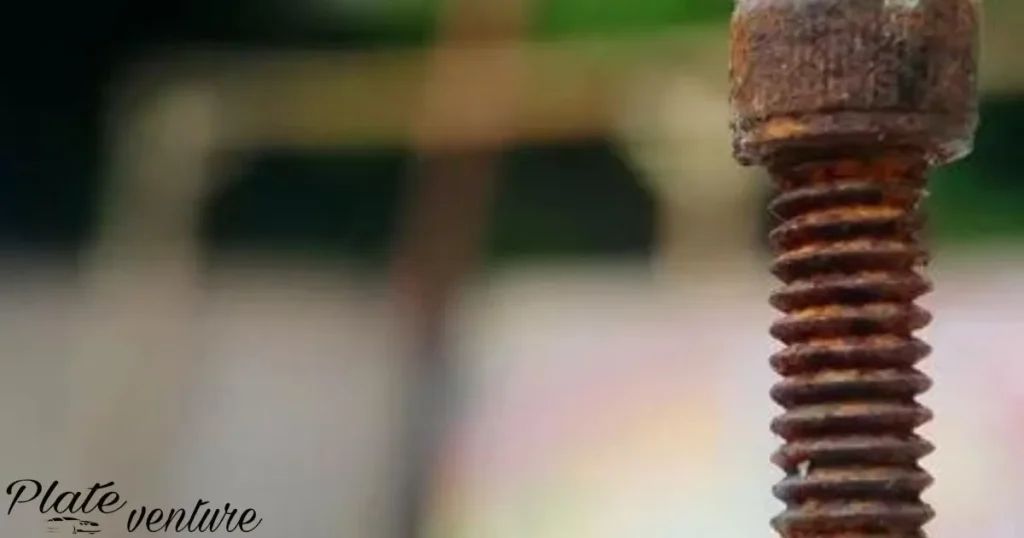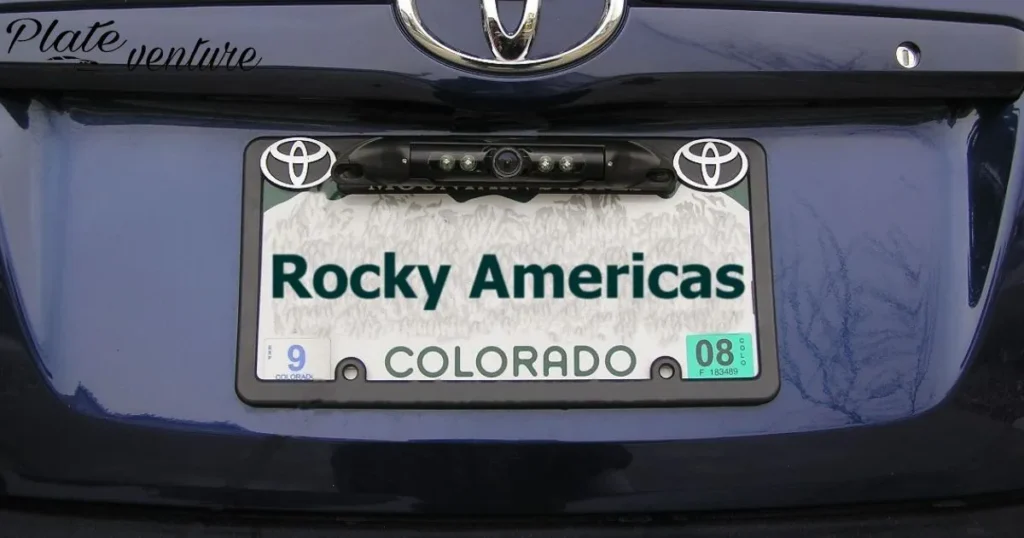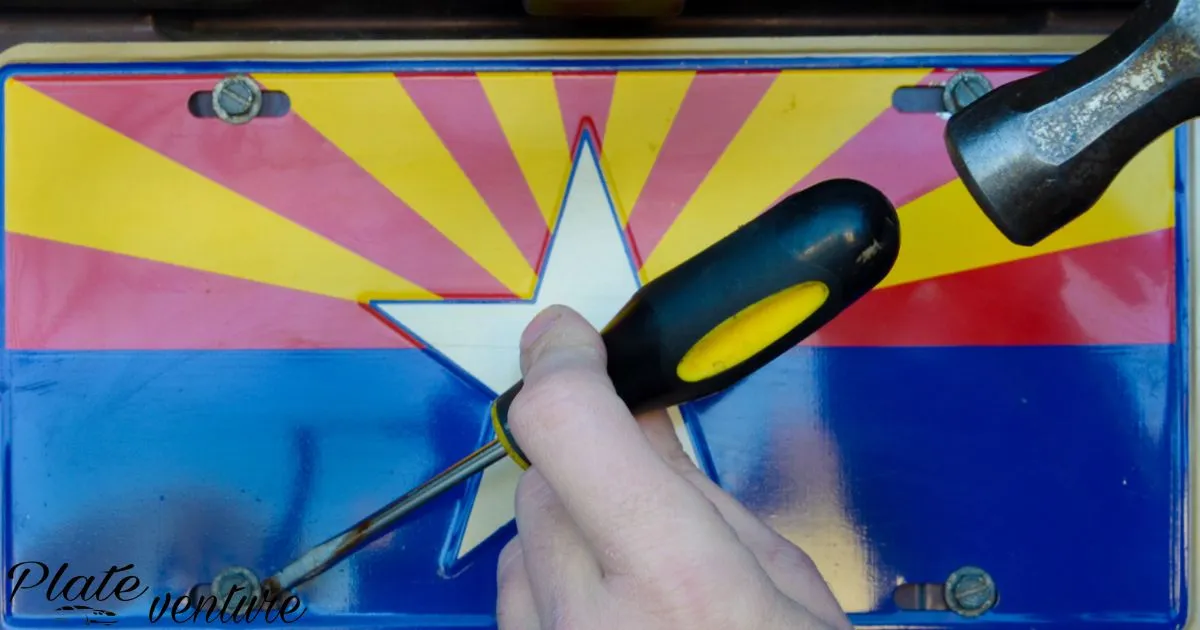Rusty screws securing a license plate to a vehicle can be very difficult to remove. Over time, exposure to water and road salt causes the screws to corrode, fusing them to the license plate holes. Removing them takes patience and the right tools. Typically, a screwdriver won’t be enough to loosen rusted screws.
How to Remove Rusted Screws From a License Plate? This is a common frustration for car owners, especially in areas with cold winters. License plates encounter snow, ice, salt, and water, causing the screws to seize up over time. While rusted screws can feel impossible to remove, there are methods that make the process much easier.
Getting rusted license plate screws out takes a little finesse. The key steps are lubricating the screws, carefully drilling pilot holes, and using screw extractors. Impact drivers may also help break them free. Drilling into the screws allows penetrating lubricants to work their way inside. Extractors bite into the screws so they can be twisted out.
How To Remove Rusted Screws From Your License Plate?
Over time, license plate screws can become rusted and difficult to remove. Start by spraying penetrating oil or rust release spray liberally on the screws and let it soak for 10-15 minutes.
Then try removing the screws with a screwdriver, being careful not to strip the heads. If they don’t budge, you may need to use vice grips or pliers to turn them. Applying heat from a hairdryer or heat gun can also help break the rust seal. Be persistent and patient in trying different methods.
Why Are My License Plate Screws Rusting?
License plate screws rust over time from exposure to water, road salt, snow, and other environmental factors. The screws endure temperature fluctuations and moisture which causes the metal to oxidize. Rust forms in the threads and bonds the screw in place, making it harder to remove. Using stainless steel screws can prevent rusting but most license plates have standard steel screws.
What Tools Do I Need To Remove Rusted License Plate Screws?
You’ll need penetrating oil or rust release spray, a phillips head screwdriver, pliers or vice grips, possibly a propane torch or heat gun, Size Of License Plate Screws and a drill with cobalt drill bits if the screw head becomes too damaged to turn with other tools. Have a variety of tools on hand because one method alone may not get the job done.
What Is The Best Way To Loosen Rusted License Plate Screws?
The best approach is to first generously spray penetrating lubricant on the screws and let it sit for 10-15 minutes. Tap the screws with a hammer to vibrate the lubricant deeper into the threads. Then alternate between trying to turn the screw with a screwdriver, gripping it tightly with locking pliers, and applying heat from a hairdryer or heat gun. Be patient and persistent.
How Can I Prevent Future Rusting Of My License Plate Screws?
To prevent screws from rusting, use stainless steel screws which resist corrosion. Apply thread sealant to help keep moisture out of the threads. Routinely remove the license plate and inspect and lubricate the screw threads. Swap out any screws that show signs of rust. Store the plate inside when not on the vehicle. Check it yearly and replace screws as needed.
What Causes License Plate Screws To Rust?

License plate screws rust due to exposure to water, salt, and humidity. The screws undergo oxidation when exposed to these elements over time, causing rust and corrosion12. This is especially common in areas with cold winters where salt is used to de-ice roads.
Does Road Salt Cause License Plate Screw Rust?
Yes, road salt is a major contributor to license plate screw rust13. The salt lingers on roads through winter and splashes onto license plates. Over time, the salt causes the screws to corrode and rust. Replacing standard screws with stainless steel or nylon screws can prevent this.
Can Humidity And Moisture Cause License Plate Screws To Rust?
Humidity and moisture are also primary causes of license plate screw rust24. Condensation combined with road salt and pollutants leads to corrosion over time. Stainless steel screws are less prone to rust caused by moisture.
Do I Need To Replace Rusted License Plate Screws?
It is recommended to replace significantly rusted license plate screws to prevent the screw heads from breaking off15. Rust also weakens the screws over time. Replacing old screws with stainless steel or nylon screws will help prevent future rust.
What Metal Should License Plate Screws Be Made Of To Resist Rust?
The best metals for rust-resistant license plate screws are stainless steel and nylon14. Stainless steel forms an oxidized layer that protects against corrosion. Nylon plastic screws will not rust at all. Both materials resist rust better than standard screws.
Methods For Removing Rusted License Plate Screws
There are several methods to try for removing rusted license plate screws, such as using penetrating oils like WD-40 to loosen the rust, using pliers or vice grips to turn the screw, or drilling out the screw as a last resort. Care should be taken not to damage the screw head or strip the screw.
Use Wd-40 To Loosen Rusted License Plate Screws
5 tips for using WD-40 to loosen rusted license plate screws:
- Spray WD-40 liberally on the screws and let it sit for 5-10 minutes to penetrate the rust. The lubricant will help loosen things up.
- Use the right sized Phillips head screwdriver to try and loosen the screws. The proper fit will allow you to apply more turning force.
- If the screwdriver slips, spray more WD-40 and let it sit before trying again. The lubricant needs time to work.
- If the screws won’t turn at all, tap firmly on the screwdriver with a hammer while turning to help break the rust seal. The impacts can help break things free.
- As a last resort if nothing else works, center punch the screws to break off the heads. Then pry off the plate and deal with the shanks later. Damaging the heads is sometimes the only way.
Will An Impact Wrench Remove Rusted License Plate Screws?
An impact wrench can generate enough torque to break loose even very stubborn rusted screws. However, take care not to over-tighten, as you may risk damaging the nut inside the trunk holding the screw in place.
Is It Safe To Drill Out Rusted License Plate Screws?
Drilling out the screw should only be done as a last resort, as you risk damaging the trunk panel. If other methods fail, you can carefully drill into the screw head to remove it. Be sure to drill slowly and straight to avoid contact with the panel.
When Should I Just Replace Rusted License Plate Screws?
If the screw head is too damaged to turn with tools, or you drill it out, you’ll need to replace the license plate screws. It’s also a good idea to replace old rusted screws during a license plate replacement to avoid dealing with stuck screws again.
How To Prevent Your License Plate Screws From Rusting
You can prevent license plate screws from rusting by using stainless steel or nylon screws, which resist corrosion better than standard screws. Also, apply a corrosion inhibitor or dielectric grease on the threads when installing new screws to protect them from water and road grime. Replacing old rusted screws regularly before they get too stubborn to remove will also help avoid being stuck with screws that are rusted in place.
Grease My License Plate Screws When Installing
Greasing screws prevents rust. It creates a moisture barrier. Use dielectric grease for metal screws. Put grease on the threads before installing. Reapply grease once a year. Silicone grease works for plastic screws.
| Action | Type of Grease | Purpose |
| Apply grease to threads before installing metal screws | Dielectric grease | Prevents rust |
| Reapply grease to metal screw threads once a year | Dielectric grease | Maintains rust prevention |
| Put grease on plastic screw threads when installing | Silicone grease | Allows screw to be removed later |
Will Stainless Steel License Plate Screws Resist Rust?
Stainless steel license plate screws are highly rust resistant and less likely to seize up compared to standard screws. The chromium content in stainless steel forms an invisible passive layer protecting the metal from corrosion. Quality stainless screws should resist rusting and last for years.
Does Using Lock Washers Help Prevent License Plate Screw Rust?
Using a nylon lock washer or second rubber washer between the license plate frame and screw head can help prevent rust. This protects the crevice where water collects by sealing out moisture better. Some lock washers also have teeth that dig into the surfaces to prevent loosening from vibration.
Where Can I Buy License Plate Screws Guaranteed Not To Rust?
Many auto parts stores sell license plate fastener kits with stainless steel screws that are rust resistant. Some brands like RSD sell black stainless screws specifically designed not to rust. Online retailers like Amazon also have screws guaranteed not to rust from various manufacturers to choose from.
Keeping Your License Plate Mounted Securely Without Rusty Screws

License plates can fall off vehicles if the screws holding them in place become loose or rusty over time. Factors like vibration from driving, temperature changes causing expansion and contraction of metals, and exposure to water and road salts can all contribute to rusting and loosening of license plate screws. Checking and tightening the screws every 6-12 months can help prevent the plate from falling off.
What Causes License Plates To Fall Off Vehicles?
The main causes of license plates falling off vehicles are rusting screws and loose screw connections. Rust forms when the metal screws are exposed to water and salt, which causes corrosion and weakening over time.
The rust prevents the screws from holding tightly, allowing vibration and bumps in the road to slowly loosen the screws until the plate detaches. Using non-metal, non-rusting screws or regular tightening of metal screws can prevent this.
How Often Should I Check That My License Plate Screws Are Tight?
Experts typically recommend checking your license plate screws every 6-12 months to ensure they remain tight. When screws loosen over time, simply tightening them with a screwdriver prevents the plate from detaching. More frequent seasonal checks may be needed in areas with extreme winter weather, where seasonal temperature changes and road salt could accelerate rusting and loosening of the screws.
Can I Use Non-Metal License Plate Fasteners To Avoid Rust?
Yes, non-metal license plate screws and bolts made from materials like plastic or stainless steel can avoid rust issues associated with standard metal fasteners. These won’t corrode from exposure to water and salts, eliminating the main cause of loosening over time. They can cost a bit more than standard screws but avoid the need to periodically check and tighten your license plate.
Frequently Asked Question
What Tools Work To Remove Rusted License Plate Screws?
Use penetrating oil, pliers, or an impact wrench to try removing rusted license plate screws first before drilling.
How Can I Loosen A Rusted License Plate Screw That Is Stuck?
Apply penetrating oil liberally and let it soak in for 10-15 minutes before trying to unscrew the rusted screw.
What If The License Plate Screw Just Spins In Place?
The interior nut likely detached – remove the license plate itself to access and grip the screw with pliers.
Is It Ok To Drill Out A Rusted License Plate Screw?
Yes, drilling allows you to remove a stubborn rusted license plate screw without damaging the mounting holes.
How Do I Prevent Future Rust On License Plate Screws?
Use stainless steel screws, apply grease before installing, check them periodically, and replace after 5-7 years.
Conclusion
Removing rusted screws from a license plate can be challenging, but is possible with some effort. First, apply penetrating oil or rust remover to the screw head and let it soak in for 10-15 minutes. This will help loosen the rust’s grip on the metal.
Next, use a manual screwdriver or electric drill with the proper sized Phillips or slotted bit to try loosening the screw. Apply firm pressure while slowly turning the screwdriver. If the screw still doesn’t budge, use a Dremel or other rotary tool to carefully grind a new slot in the screw head to fit a flathead screwdriver. Finally, once you get the rusted screw to turn, keep steady pressure while unscrewing it completely.
In conclusion, getting rusted license plate screws off just takes patience, the right tools, and techniques like lubricating penetrants, slot grinding, and manual torque. Work slowly and carefully to avoid snapping the screw head off. With perseverance, you can defeat the stubborn rust.








